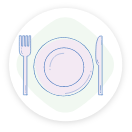Tips To Handle A Choosy Eater
Handing a peeled apple slice to her mother, two-year-old Amelia demanded, “Cut it!” This active, apple-loving toddler then began shrieking, “Cut it! Cut it!” Amelia’s mom noticed a speck of peel and removed it with a smile. “Woops, missed some!” she said and gave the slice back to Amelia — who happily took a bite.
Amelia used to eat apples with peels, but recently, she’s been inspecting her food, refusing to eat stew unless the potatoes and carrots are separated, and rejecting foods she once loved.

A child’s personality plays a big part in eating habits. An easygoing child may be less picky or put up less of a fuss, while a cautious or more spirited child may become upset if you try to get them to eat.
Amelia is more choosy than her brother was at this age, with stronger opinions about how and what she eats. While sometimes frustrating, Amelia’s reactions are normal for many toddlers.

